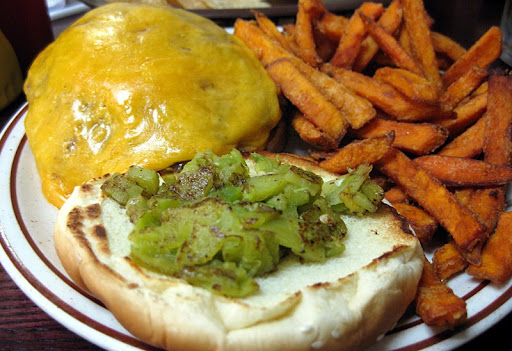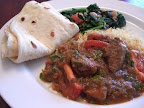All Grain Brewing on the Stovetop, and a "Half Nelson" IPA Recipe

We've been wanting to try all grain brewing for quite some time now. Moving to partial mash brewing made a huge difference in the quality of our beers, and we were curious about how much more we could gain from going all grain.
But, every time we thought about taking the plunge, we always balked at the logistics. A 5-gallon brew pot wouldn't fit on our stove top, so we'd need to get a burner for the patio. Then the hassle of getting the three-tiered set up of hot sparge water above the grain bed to be drained into a huge brew pot. And finally, trying to cool the big 5-gallon pot of wort, then lugging it into the house to transfer to the carboy for fermentation... It just seemed like too much.
Then one day a simple solution occurred to us - we could just do a half batch! Essentially, doing a standard partial mash but omitting the extract and keeping the final batch size at 2.5 gallons gets you an all grain beer.
The obvious drawback is that you only get 2.5 gallons of beer, while doing almost the same amount of work as for a 5 gallon partial mash. But still, it is all-grain brewing on the stovetop with no more equipment than you need for partial mash.
We happened to have some Nelson Sauvin hops on hand, so we decided to brew a beer featuring them. The result was a very nice, light (both in color and body - it is lighter than it looks in the photo) and clean tasting beer. Was it better than what we get with partial mash? Hard to say, since we've never worked with the Nelson hops before. We will have to give the technique a try with one of our more standard IPA recipes.
Given the half batch, and the use of the Nelson, we couldn't possibly have named the beer anything other than "Half Nelson" IPA.
Total batch size = 2.5 gallons; All Grain Mash in 3 gallon beverage cooler; 2.5 to 3 gallon 60 minute stove-top boil; dry hopped for aroma; target abv of 6%.
1/4 lb Wheat Malt
1/4 lb Carapils/Dextrin Malt
2 oz Nelson Hops (8.0% AA)
1/2 oz Centennial Hops (8.8% AA)
3/4 oz Simcoe Hops (12.3% AA)
1 tablet Whirlfloc
White Labs WLP051 California Ale V Yeast
1/4 oz Centennial - 45 minutes boil
1/2 oz Nelson - 45 minutes boil
1/4 oz Nelson - 30 minutes boil
1/4 oz Simcoe - 30 minutes boil
1/4 oz Simcoe - 15 minutes boil
1/4 oz Nelson - 2 minutes boil
1 oz Nelson- Dry Hop in Secondary Fermenter
1/4 oz Simcoe - Dry Hop in Secondary Fermenter
Heat 8 quarts water to 167 degrees for a target mash temperature of about 152 degrees. Place the crushed grain (2-Row Pale, Wheat and Carapils) into a large mesh bag. Pour the hot water into the beverage cooler, then lower the grain bag into the water very slowly, pushing and prodding with a large spoon to ensure all the grain is wet (this can take several minutes). Put the lid on the cooler and allow to rest 60 minutes.
While the grains are mashing, heat another 5-6 quarts of water to 180-185 degrees for sparging (rinsing the grains). Near the end of the 60 minutes, heat 2 quarts of water to a boil in your brew pot.
After the first mash is complete, remove the cooler lid and open the spigot to draw off about 2 quarts of wort into a large pitcher. The first few draws will likely be cloudy with grain particles; pour it gently back into the cooler over the grain bag to help filter it. Draw off the remaining wort by the pitcher-full and carefully pour that wort into the boiling water in your brew pot; continue until only a trickle of wort leaves the spigot. Pour about 5 quarts of your hot sparge water over the grain bag in the cooler. Gently lift the bag up and down to thoroughly re-wet the grains (but don't slosh). Cover and let sit about 5 minutes. Use the spigot and a pitcher to draw off all of the second wort and add it to your brew pot.
You should have about 3 gallons of wort. Bring the wort to a boil and add hops according to the schedule. With 15 minutes remaining in the boil, stir in 1 tablet Whirlfloc. At time zero, remove the pot from the heat, cover and let sit 10-15 minutes.
Move brew pot to an ice bath and cool quickly to less than 80 degrees. Transfer wort to a primary fermenter (straining off the hops if desired). Add water to reach the 2.5 gallon mark if necessary. Swirl vigorously then pitch the yeast.
Ferment in primary for 1 week, then transfer to secondary. After seven days, dry hop with 1 oz Nelson and 1/4 oz Simcoe. Bottle or keg after fermentation is complete (2 to 3 weeks in secondary).














